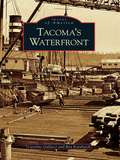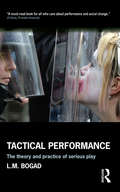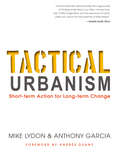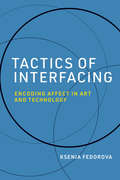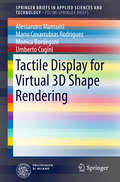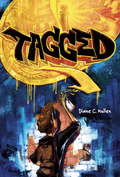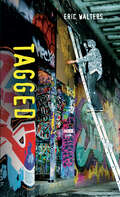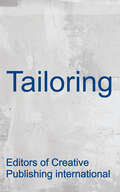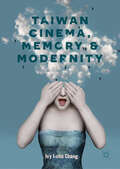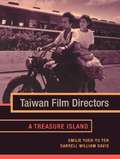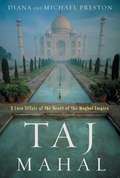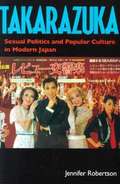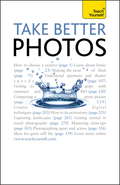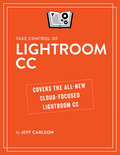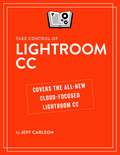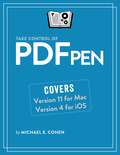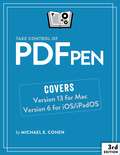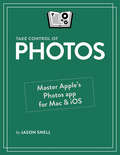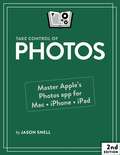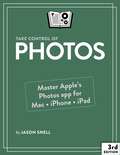- Table View
- List View
Tacoma's Waterfront (Images of America)
by Ron Karabaich Caroline GallacciFor more than 150 years, the activity on and around Commencement Bay-since the 1840s, when Charles Wilkes first named it, to the present day-has been a barometer for measuring Tacoma's maritime and industrial growth and development. Wilkes's early exploration assured the inclusion of Puget Sound within the boundaries of the United States following negotiations with Great Britain in 1846. Drawn to the deep waters of the south shore of the bay, the Northern Pacific Railroad established its transcontinental terminus here in 1873 and, in the process, created the city of Tacoma. In the early years, the waterfront was alive with the sights and sounds of commerce. The "longest wheat wharf in the world" lined the south shoreline, longshoremen handled cargo, the Mosquito Fleet carried people to and from the municipal dock, and the Puyallup River delta was transformed into the bustling Port of Tacoma.
Tactical Media (Electronic Mediations #28)
by Rita RaleyTactical media describes interventionist media art practices that engage and critique the dominant political and economic order. Rather than taking to the streets and staging spectacular protests, the practitioners of tactical media engage in an aesthetic politics of disruption, intervention, and education. From They Rule, an interactive map of the myriad connections between the world&’s corporate and political elite created by Josh On and Futurefarmers, toBlack Shoals, a financial market visualization that is intended to be both aesthetically and politically disruptive, they embrace a broad range of oppositional practices.In Tactical Media, Rita Raley provides a critical exploration of the new media art activism that has emerged out of, and in direct response to, postindustrialism and neoliberal globalization. Through close readings of projects by the DoEAT group, the Critical Art Ensemble, Electronic Civil Disobedience, and other tactical media groups, she articulates their divergent methods and goals and locates a virtuosity that is also boldly political. Contemporary models of resistance and dissent, she finds, mimic the decentralized and virtual operations of global capital and the post-9/11 security state to exploit and undermine the system from within. Emphasizing the profound shift from strategy to tactics that informs new media art-activism, Raley assesses the efficacy of its symbolic performances, gamings, visualizations, and hacks. With its cogent analyses of new media art and their social impact, Tactical Media makes a timely and much needed contribution to wider debates about political activism, contemporary art, and digital technology.
Tactical Performance: Serious Play and Social Movements
by Larry BogadTactical Performance tells fun, mischievous stories of underdogs speaking mirth to power - through creative, targeted activist performance in the streets of cities around the world. This compelling, inspiring book also provides the first ever full-length practical and theoretical guide to this work. L.M.Bogad, one of the most prolific practitioners and scholars of this genre, shares the most effective non-violent tactics and theatrics employed by groups which have captured the public imagination in recent years. Tactical Performance explores carnivalesque protest in unique depth, looking at the possibilities for direct action and sometimes shocking confrontation with some of the most powerful institutions in the world. It is essential reading for anyone interested in creative pranksterism and the global justice movement.
Tactical Urbanism: Short-term Action for Long-term Change
by Mike Lydon Anthony Garcia Andres DuanyIn the twenty-first century, cities worldwide must respond to a growing and diverse population, ever-shifting economic conditions, new technologies, and a changing climate. Short-term, community-based projects--from pop-up parks to open streets initiatives--have become a powerful and adaptable new tool of urban activists, planners, and policy-makers seeking to drive lasting improvements in their cities and beyond. These quick, often low-cost, and creative projects are the essence of the Tactical Urbanism movement. Whether creating vibrant plazas seemingly overnight or re-imagining parking spaces as neighborhood gathering places, they offer a way to gain public and government support for investing in permanent projects, inspiring residents and civic leaders to experience and shape urban spaces in a new way. Tactical Urbanism, written by Mike Lydon and Anthony Garcia, two founders of the movement, promises to be the foundational guide for urban transformation. The authors begin with an in-depth history of the Tactical Urbanism movement and its place among other social, political, and urban planning trends. A detailed set of case studies, from guerilla wayfinding signs in Raleigh, to pavement transformed into parks in San Francisco, to a street art campaign leading to a new streetcar line in El Paso, demonstrate the breadth and scalability of tactical urbanism interventions. Finally, the book provides a detailed toolkit for conceiving, planning, and carrying out projects, including how to adapt them based on local needs and challenges. Tactical Urbanism will inspire and empower a new generation of engaged citizens, urban designers, land use planners, architects, and policymakers to become key actors in the transformation of their communities.
Tactics of Interfacing: Encoding Affect in Art and Technology (Leonardo)
by Ksenia FedorovaHow digital technologies affect the way we conceive of the self and its relation to the world, considered through the lens of media art practices.In Tactics of Interfacing, Ksenia Fedorova explores how digital technologies affect the way we conceive of the self and its relation to the world. With the advent of ubiquitous computing, the self becomes an object of technological application, increasingly defined by data received from tracking technologies. Subtly, these technologies encourage versions of ourselves that are easier to interpret computationally. Fedorova views these shifts in self-perception through the lens of contemporary media art practices, examining a range of artistic tactics that enable embodied and intimate experiences of machinic operations on our lives.
Tactile Display for Virtual 3D Shape Rendering
by Monica Bordegoni Alessandro Mansutti Mario Covarrubias Rodriguez Umberto CuginiThis book describes a novel system for the simultaneous visual and tactile rendering of product shapes which allows designers to simultaneously touch and see new product shapes during the conceptual phase of product development. This system offers important advantages, including potential cost and time savings, compared with the standard product design process in which digital 3D models and physical prototypes are often repeatedly modified until an optimal design is achieved. The system consists of a tactile display that is able to represent, within a real environment, the shape of a product. Designers can explore the rendered surface by touching curves lying on the product shape, selecting those curves that can be considered style features and evaluating their aesthetic quality. In order to physically represent these selected curves, a flexible surface is modeled by means of servo-actuated modules controlling a physical deforming strip. The tactile display is designed so as to be portable, low cost, modular, and high performing in terms of the types of shape that it can represent.
Tadeusz Kantor (Routledge Performance Practitioners)
by Noel WittsTadeusz Kantor – a theoretician, director, innovator and painter famed for his very visual theatre style – was a key figure in European avant-garde theatre. He was also known for his challenging theatrical innovations, such as extending stages and the combination of mannequins with living actors. The book combines: a detailed study of the historical context of Kantor’s work an exploration of Kantor’s own writings on his theatrical craft a stylistic analysis of the key works, including The Dead Class and Let the Artists Die, and their critical reception an examination of the practical exercises devised by Kantor. As a first step towards critical understanding, and as an initial exploration before going on to further, primary research, Routledge Performance Practitioners offer unbeatable value for today’s student.
Tagged
by Diane C. MullenLiam is a fourteen-year-old graffiti artist living in project housing in Minneapolis with his single mother and two younger siblings. When Liam's estranged older brother coerces him to tag a graffiti symbol for a rival gang, Liam's life is threatened. Due to his apathetic attitude in the classroom and on the baseball field, Liam's private-school scholarship is also threatened. His mother decides to send him to Lake Michigan for the summer to live with her best friend, Kat, a sculptor and art teacher, Liam soon delves into the work of Jean-Michel Basquiat, Pablo Picasso, and his own personal aesthetics. He's encouraged to consider his art seriously and how it might contribute to a greater community. Having to decide between staying with Kat and returning home to his siblings who need him, Liam's story inspires him to reinvent himself for the better.
Tagged (Orca Soundings)
by Eric WaltersThe city is cracking down on graffiti and guerilla art. Between that and cutbacks to the local art gallery it seems like nothing is safe. But Oswald, masquerading as a graffiti artist known as The Wiz, is fighting back--by painting elaborate murals in public places and planting art in the galleries, and then by taking on the mayor himself. As the fight escalates and the stakes become higher, Oswald gets in deeper than he meant to and needs to rely on his friends to get him out of his latest mess.
Tailoring: The Classic Guide to Sewing the Perfect Jacket
by Editors of Creative Publishing internationalWritten by sewing professionals, this book teaches the trusted, proven methods for sewing tailored jackets with impeccable details and perfect fit. Written for the intermediate sewer who wants to move on to more challenging projects, this book ensures success with detailed, step-by-step instructions, more than 400 photos, in-depth discussions about products and how to use them.
Tails from the Exotic Feline Rescue Center, 25th Anniversary Edition
by Bill Nimmo Joe Taft Stephen D. MccloudMeet Sahib, Sampson, Zulu, Rouge, Blaze--just a few of the 200 big cats that await visitors at the Exotic Feline Rescue Center. The EFRC, in Center Point, Indiana, is a nationally recognized leader in big cat rescue, conservation, and care. Almost all of these cats--tigers, bobcats, lions, pumas, and servals--are survivors of abuse and neglect. In this follow-up to Saving the Big Cats and Real Stories of Big Cat Rescues, photographer Stephen D. McCloud showcases the newest residents of this lush 108-acre sanctuary, now celebrating its 25th anniversary. Readers will be fascinated by the stories of these incredible feline predators in this anniversary edition, which includes a foreword by Tigers of America founder Bill Nimmo.
Taiwan Cinema, Memory, and Modernity
by Ivy I-chu ChangThis book investigates the aesthetics and politics of Post/Taiwan-New-Cinema by examining fifteen movies by six directors and frequent award winners in international film festivals. The book considers the works of such prominent directors as Edward Yang, Tsai Ming-liang and Chang Tsuo-chi and their influence on Asian films, as well as emergent phenomenal directors such as Wei Te-sheng, Zero Chou, and Chung Mong-hong. It also explores the possibility of transnational and trans-local social sphere in the interstices of layered colonial legacies, nation-state domination, and global capitalism. Considering Taiwan cinema in the wake of globalization, it analyses how these films represent the socio-political transition among multiple colonial legacies, global capitalism, and the changing cross-strait relation between Taiwan and the Mainland China. The book discusses how these films represent nomadic urban middle class, displaced transnational migrant workers, roaming children and young gangsters, and explores how the continuity/disjuncture of globalization has not only carved into historical and personal memories and individual bodies, but also influenced the transnational production modes and marketing strategies of cinema.
Taiwan Film Directors: A Treasure Island (Film and Culture Series)
by Emilie Yueh-yu Yeh Darrell William DavisFocusing on the work of four contemporary filmmakers—Ang Lee, Edward Yang, Hou Hsiao-hsien, and Tsai Ming-liang—the authors explore how these filmmakers broke from tradition, creating a cinema that is both personal and insistent on examining Taiwan's complex history. Featuring stills, anecdotes, and close readings of films, the authors consider the influence of Hong Kong and martial arts films, directors' experiments with autobiography, the shifting fortunes of the Taiwanese film industry, and Taiwan cinema in the context of international cinema's aesthetics and business practices.
Taj Mahal: Passion And Genius At The Heart Of The Moghul Empire
by Diana Preston Michael PrestonWhile Galileo suffered under house arrest at the hands of Pope Urban VIII, the Thirty Years War ruined Europe, and the Pilgrims struggled to survive in the New World, work began on what would become one of the Seven Wonders of the World: the Taj Mahal. Built by the Moghul emperor Shah Jahan as a memorial to his beloved wife, Mumtaz Mahal, its flawless symmetry and gleaming presence have for centuries dazzled everyone who has seen it, and the story of its creation is a fascinating blend of cultural and architectural heritage. Yet, as Diana & Michael Preston vividly convey in the first narrative history of the Taj, it also reflects the magnificent history of the Moghul Empire itself, for it turned out to mark the high point of the Empire's glory at the same time as it became a tipping point in Moghul fortunes.
Takarazuka: Sexual Politics and Popular Culture in Modern Japan
by Jennifer E. RobertsonFounded in 1913 as a counterpart to the all-male Kabuki theater, the all-female Takarazuka Revue is world-famous today for its rococo musical productions and fanatically devoted fans. Anthropologist Jennifer Robertson draws from over a decade of research to explore how the Revue illuminates popular culture in 20th-century Japan. 29 photos.
Take Better Photos: Teach Yourself
by Lee FrostTake Better Photos: Teach Yourself is your complete guide to all the practical know-how, technical information and creative insight that will turn you into a confident user of your camera. Covering the very latest in equipment, with essential and straightforward guides to all the techniques - from exposure to use of flash - it will also teach you how to use digital manipulation, software and all the other technology that will make your pictures strong and memorable. It explains how to do everything from choosing the camera that's right for you to composing your shots, along with helpful screengrabs showing you how to get the desired result on screen and paper alike. NOT GOT MUCH TIME? One, five and ten-minute introductions to key principles to get you started. AUTHOR INSIGHTS Lots of instant help with common problems and quick tips for success, based on the authors' many years of experience. TEST YOURSELF Tests in the book and online to keep track of your progress. EXTEND YOUR KNOWLEDGE Extra online articles at www.teachyourself.com to give you a richer understanding of photography. THINGS TO REMEMBER Quick refreshers to help you remember the key facts.
Take Control of Buying a Digital Camera
by Laurence ChenFind practical, real-world advice that helps you choose a digital camera!This book helps you cut through the marketing hype and confusing jargon to find the digital camera that's right for you. You'll learn which camera features are important, which ones aren't, and why. Rather than bury you with arcane technical details or a myriad of camera models, Larry first helps you determine how much you want to spend, what sort of pictures you're likely to take, and what aspects of using a camera are important to you. With that grounding, you're ready to learn about the different camera features, separated by those that are actually important and those that merely fill up feature checklists. The ebook even contains a camera comparison worksheet you can fill in while shopping. Additional sections give you pointers on how to read camera reviews (plus a list of the best review sites!), advice about evaluating picture quality, suggestions of where to buy your camera, the lowdown on accessories you might want, and tips on working with photos on your computer. Includes a coupon worth $5 off any order at Small Dog Electronics, chopping the price of this ebook in half if you buy your camera from Small Dog!
Take Control of Lightroom CC
by Jeff CarlsonImport, manage and edit your photos expertly with Lightroom CC!As more and more of us access and edit photos on many different devices--laptops, desktops, tablets, and phones--we increasingly expect a seamless experience, with our images and edits showing up on all our devices, immediately. To accommodate this shift, Adobe has released a new version of its Lightroom application, Lightroom CC, that is specifically designed for cloud interaction. Lightroom CC is streamlined and simplified, meant to appeal to those who want to do more than the basics with their photos, but who are intimidated by Lightroom Classic CC and Photoshop.In Take Control of Lightroom CC, photography expert Jeff Carlson gives a thorough, but accessible, guide to the new Lightroom CC. He explains where it fits in the Lightroom ecosystem, then moves on to detail how to import, manage, and professionally edit your photos using Lightroom CC. For those who want to keep using Lightroom Classic CC, he also looks at how the two programs can work together.With this book, you'll:Get the big picture: See how Lightroom CC and Lightroom Classic (as well as Lightroom Mobile and Lightroom for Web) work together Build your photo library: Learn how to import photos from cameras, memory cards, and locations on your hard disk; automatically add mobile photos; and sync photos, taking advantage of Lightroom CC's cloud-focused features. Organize your photos: Organize your photo library with rating and tagging, find photos using Adobe Sensei, manage your storage options, and back up your library.Edit your photos: Get a handle on essential editing basics (like working in the Edit panel); use crop, straighten, rotate and flip to re-orient photos; adjust lighting, color, and appearance; and apply presets.Share your photos: Post images directly to your friends online in Facebook, export them to disk in order to share them elsewhere, or make an entire album public for people to view and, optionally, to download.Work with Lightroom Classic CC: Learn how to migrate a Classic catalog, or discover how to run both programs together.
Take Control of Lightroom CC
by Jeff CarlsonThis book gives you all the information you need to use Lightroom CC, Adobe’s all-new desktop photo editor and organizer, from understanding where it fits in the Lightroom ecosystem (alongside Lightroom Classic, the rebranded and updated version of the traditional Lightroom application), to importing, managing, and professionally editing your photos.
Take Control of PDFpen
by Michael E. CohenPolish your PDFs with Smile's PDFpen, for a fraction of what Adobe Acrobat costs! Michael E. Cohen explains how you can create, combine, edit, annotate, and protect PDFs. Also learn how to perform and edit OCR, fill out forms, sign forms digitally, make interactive forms, and much more. Covers Mac and iOS versions!
Take Control of PDFpen
by Michael E. CohenPolish your PDFs with Smile's PDFpen, for a fraction of what Adobe Acrobat costs! Michael E. Cohen explains how you can create, combine, edit, annotate, and protect PDFs. Also learn how to perform and edit OCR, fill out forms, sign forms digitally, make interactive forms, and much more. Covers Mac and iOS versions!
Take Control of PDFpen
by Michael E. CohenPolish your PDFs with Smile's PDFpen, for a fraction of what Adobe Acrobat costs! Michael E. Cohen explains how you can create, combine, edit, annotate, and protect PDFs. Also learn how to perform and edit OCR, fill out forms, sign forms digitally, make interactive forms, and much more. Covers Mac and iOS/iPadOS versions!
Take Control of Photos
by Jason SnellTake control of your photo collection in Photos for Mojave and iOS 12!Get to know Apple's Photos app and how best to use it to import, manage, edit, and share your photos in Mojave and iOS 12! As the successor to Apple's iPhoto and Aperture apps, Photos has a more refined interface and deeper connections to iCloud, and it runs faster. Following the expert advice of Jason Snell, publisher of Six Colors and former lead editor at Macworld, you'll learn how to navigate Photos like a pro!This 156-page book replaces and more than doubles the length of Jason's previous book Photos: A Take Control Crash Course. It's now a full-length Take Control title with much more detail.In this book, you'll learn how to:Migrate your library from iPhoto or Aperture (Apple's discontinued professional photography app) into PhotosImport photos from devices or memory cardsUse multiple Photos librariesNavigate the Photos interface, including the sidebar and iconsView, edit, or disable Live PhotosOrganize your library by using enhanced search features, adding metadata, building albums, and creating smart albumsEdit your photos using quick fixes like cropping, applying filters, and fixing red-eye and rotation problemsUse advanced editing techniques within Photos and edit using external apps like PhotoshopManage your photo collection using the Memories and People features, and get summary viewsSync and share your photos with iCloudView your photos on an Apple TVShare your photos via social media, export them out of Photos, or turn them into slideshowsCreate printed objects (such as books and calendars) from your photos using third-party servicesJason also highlights changes in Photos under iOS 12, including searching for multiple items at once, a For You tab, and an updated Import tab; plus changes in Mojave, including new keyboard shortcuts and the removal of built-in features for making calendars, books, and other printed materials (and alternative means of obtaining them).This book, which is about the new versions of Photos that Apple released in September 2018, covers Photos for macOS version 4.0 in Mojave, as well as Photos in iOS 12 and tvOS 12.
Take Control of Photos
by Jason SnellThis book introduces you to the many features of Apple’s Photos app on Mac, iPad, and iPhone, with advice on navigating the interface, editing your images, searching your library like a pro, syncing with iCloud Photos, sharing photos with others, and creating photo books.
Take Control of Photos
by Jason SnellThis book introduces you to the many features of Apple’s Photos app on Mac, iPad, and iPhone, with advice on navigating the interface, editing your images, searching your library like a pro, syncing with iCloud Photos, sharing photos with others, and creating photo books.
